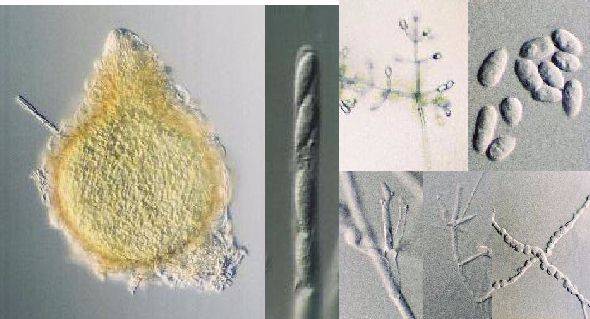
e Fig-1. Hypomyces sympodiophorus
Hypomyces sympodiophorus Rogerson & Samuels, Mycologia, 85: 241, 1993.
Anamorph:
Cladobotryum uniseptatum (Castaneda) K. Poldmaa, Mycologia, 91: 192, 1999.
|
Hypomyces sympodiophorus Rogerson & Samuels, Mycologia, 85: 241, 1993. Anamorph: Cladobotryum uniseptatum (Castaneda) K. Poldmaa, Mycologia, 91: 192, 1999. Teleomorph in nature Subiculum on the substrate is white, covering the entire surface of host hymenium, parenchymatous, KOH(-); the hyphae are 2.5-5(-15) Κm wide, septate, thick-walled. Perithecia are white to pale yellow (Munsell 5Y9/2, Methuen 3A3) to straw yellow (Munsell 5Y8/4, Methuen 3B4), pyriform, (190-)220-250(-300) x 210-250(-270) Κm, grouped on the surface of subiculum mat, having a conical beak with flat apex, (80-)100-110 x (70-)100-120(-180) Κm, bearing an ostiole of 20-30(-80) mm wide, KOH(-); the walls are composed of several layers of angular cells of 7.5-25 x 6.5-17.5 Κm, 7.5-17.5 Κm thick; the beaks consist of angular cells of 10-20 x 10-12.5 mm, 15-37.5 mm thick, with inner peripheral hairs. Asci are cylindrical, (107.5-)130-132.5(-145) x (4.5-)5-5.5(-6.5) Κm, 8-spored, with a stalk of 5-7.5 mm in length, having slightly thick-walled apical part; apical pores are 1.5-2(-4.5) Κm in diam. Ascospores are hyaline, long ellipsoidal to asymmetrical fusiform with a central transverse septum, (14.5-)15-17.5(-20) x 4.5-5.5(-7.5) Κm, with minute warts of 0.05-0.1 Κm in diam., having rounded terminals. Characteristics in cultures Colonies on MEA, oA, or PDA grew moderately to reach 15-25 mm after 5 days at 25C, velutinous, white to pale yellow (Munsell 5Y9/2, Methuen 3A3), light yellow (Munsell 5Y9/6, Methuen 3A5) in the center, forming concentric zones of hyphal layers; margins are entire to undulate; odorless; the reverse are colorless to pale yellow and Pastel yellow, Light yellow to Vivid yellow(Munsell 5Y9/2, 5Y9/4, 5Y9/6, 5Y8/10. Methuen 3A3, 3A4, 3A5, 3A8.). Hyphae are hyaline, septate, thin-walled, (2.5-)3.5-5 Κm wide. Conidiophores arise from aerial hyphae, macronematous, septate, slightly thick-walled, irregularly branched 2- to 3-times, bearing conidiogenous cells at the apex, 90-150(-500) x 3.0-5.0 Κm. Conidiogenous cells are born laterally or apically in a verticl of (3-)4-6 on the conidiophores, hyaline, (14-)16-18(-24) x 2.0-3.0(-4.5) Κm, lanceolate, straight tapering toward the apex, sometimes with 2 to 3 minute terminal denticles, 0.5-1.5(-2.5) Κm wide. Conidia are solitary, hyaline, 0-1 septate, broadly ellipsoidal to cylindrical, thin-walled, smooth, 9-14(-16) x (3-)6.5-9 Κm. Chlamydospores are formed laterally on the substrate hyphae, in chains, hyaline, smooth, barrel-shaped, (4-)7-10 Κm. No ascosporic state was observed in cultures. Habitat: on polypores Known distribution: USA., France, Estonia, and Japan Specimen examined: on the fruiting bodies of Stereum ostrea (Blume & Nees: Fr.) Fr., collected near Lake Hadori,
Shirakawa, Fukushima Pref., Japan, on September 3, 2000, by Toshiyuki Tokiwa
(Specimen KPM-NC0009256, culture: KS00060 = TAMA F2717); Potapsco Valley State
Park, Prince Georgefs Co., Maryland, USA., on August 27, 2000, Leg G. Arnold,
determined by K. Poldmaa, conidial (culture, GA 00-105) References
|
Top